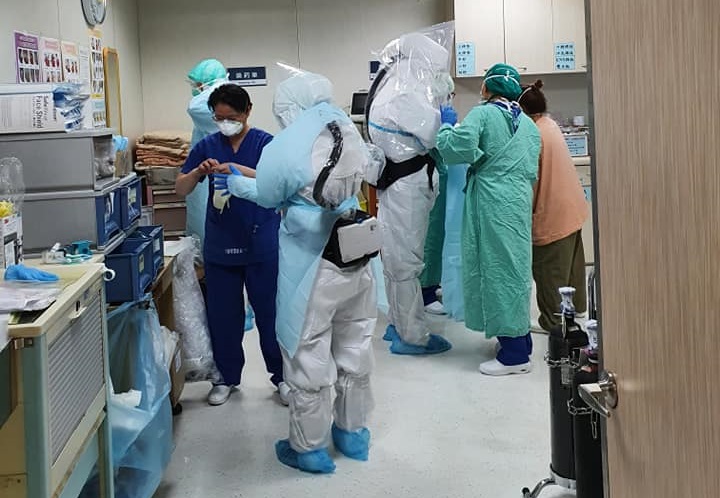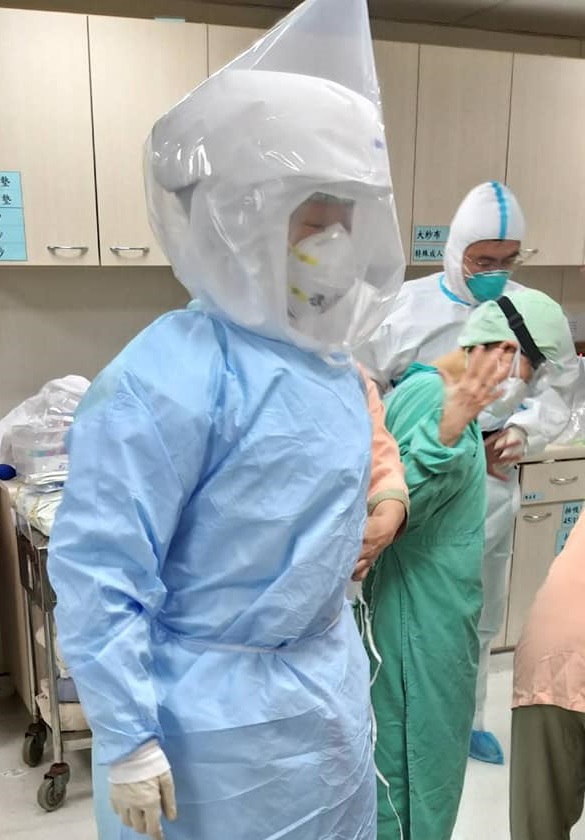
Many people still falsely believe that not using life-sustaining medical care or receiving intensive care is equivalent to giving up medical care altogether. However, the spirit of hospice and palliative care lies in respecting the client's medical choices. To this day, in a society where human rights are progressing, the final parting decision should be recognized and respected.
The COVID-19 pandemic is like tinder ready to burst and start an accidental, uncontrollable wildfire. In May 2021, the pandemic in Taiwan escalated to the third level of alert. As the number of confirmed cases increased, the death toll kept rising. In the face of doubts from the outside world about domestic medical capability, the official representative once stated that the reason why the death toll remained high was because patients and their families signed the DNR (Do Not Resuscitate), resulting in deaths of those who could have been saved, but were not.
"This may seem logical based on the results of COVID-19," says Dr. Pin-Kuei Fu, director of the respiratory intensive care unit of Taichung Veterans General Hospital. Having worked for more than 10 years in the frontline of the intensive care unit, Dr. Fu analyzed that signing a DNR is never the same as giving up treatment. He says, "Only when one is diagnosed as terminal based on the clinical symptoms by two specialist doctors will DNR actually take effect.”
Terminal Diagnosis: Firmly Protecting the Well-being of the Patient
Known as Taiwan's Mother of Hospice, Prof. Co-Shi Chantal Chao once said at the North Public Hearing concerning the Patient Autonomy Law, "There are two things that are most worrying in the Hospice Palliative Care Act: insufficient medical care and excessive medical treatment.”
Dr. Pin-Kuei Fu further explained that when the patient is in a situation where he or she should not receive too much invasive treatment and the medical team still gives it, it is considered excessive medical treatment; on the other hand, when the patient's condition does not meet terminal diagnosis, but because the patient or family members have signed the DNR, the medical team gives up treatment, this is called insufficient medical treatment. "The key to avoiding excessive or insufficient treatment is the doctor’s confirmation of whether the patient is in a terminal condition or not."
Dr. Fu said that the patient’s greatest well-being must resort to professional judgment. The Hospice and Palliative Care Act clearly stipulates that one can sign the DNR as long as he or she reaches 20 years old, but does the signing mean that the person is a terminal patient? Of course not. It must be confirmed by two specialist doctors that he or she has entered the terminal stage before this DNR is put into effect,” Dr. Fu emphasizes.
Working in the ICU, Dr. Fu has seen many patients come and go. He regrettably has waved goodbye to many patients passing away and witnessed the tenacity of countless lives. A patient was once admitted to the ICU when the influenza virus and legionella pneumophila were gnawing at his life bit by bit. The patient's condition was like a withered and dying leaf. Just as the medical team was preparing to start rescue efforts, the patient’s wife said, “Doctor, please don’t give first aid. Our whole family has signed a DNR.”
Based on years of professional experience, Dr. Fu knew clearly that although the patient’s breath was weak, his life had not yet come to the end, so he told his family in a firm and tactful tone, "As far as my judgment is concerned, he is not in his final state and can still be treated."
By treatment, Dr. Fu meant recovery, and all the essential elements for a successful recovery are effectively reversible medical treatment. At that time, this patient did not have sufficient conditions for the doctor to diagnose him as being in the terminal stage yet. Facing relatives who found it unbearable to see their family members struggling in the pain of medical emergency care, Dr. Fu comforted them to say that in the ICU, intensive care and palliative care are not in conflict; they can even be carried out simultaneously, but the proportion will be adjusted according to the progress of the disease and the needs.
"We helped the patient with a blood pressure booster, installed a kidney dialysis machine and ECMO, and performed a tracheostomy." As the patient's condition gradually improved, the team removed the life-sustaining equipment one by one until he recovered and was discharged from the hospital. "A few months later, the patient came to thank me personally, saying that I saved his life. He even remembered during his time staying in the ward, that I often leaned to his ear and whispered ‘Jia You’ [a popular Mandarin phrase meaning ‘Don’t give up’]." Even though the patient's course had already progressed to multiple organ failures, Dr. Fu said with certainty that DNR would not be necessary, given that the medical team had determined his condition was not in the final stage, and that as long as there was an opportunity, the doctors and nurses would try their best to provide the care for the patient to have a future fruitful life again.
Prepare Everything in Advance for the Sake of the Patient
Now that all Taiwan is facing the challenge of the COVID-19 pandemic, the course of the disease often changes rapidly. When all is considered for a patient and there is still a chance for recovery, the next second he or she may still quickly lead to exhaustion, and a DNR decision could often happen in an instant.
With regard to this rapid change of course, Dr. Wan-Ting Hsieh, director of Palliative Medicine Department at Chimei Hospital and who has been in the field of hospice and palliative care for 10 years, said that the so-called hospice care is about the patient's autonomous decision-making. When suddenly caught by a severe disease like COVID-19, whether the patient is conscious enough to make rational medical treatment choices is full of uncertainties.
Looking at the relevant domestic and foreign literature, most experts and scholars agree that when facing infected patients, medical staff should have a holistic discussion about the follow-up treatment policy before the start of treatment. They should also anticipate and discuss in advance what kind of care the patient will want when the condition begins to deteriorate.
"Hospice care is the type of care chosen after evaluation and communication between the doctor and the patient. It is definitely not a so-called early abandonment," insists Dr. Hsieh. In fact, there is no such thing as a so-called early abandonment in the medical setting. Every decision is based on the patient's needs and wants. Nevertheless, when the misunderstanding or outlook that "going to hospice is equal to giving up" arises, "this is actually a very big hurt, whether for the decision-maker or for the medical team engaged in palliative care, as it implies that they do not care or value life."

Hospice and Palliative Care Is an Art of Caring
In Dr. Wan-Ting Hsieh's view, hospice care is not just another way of care, but it is an art of caring staged on the medical scene. This art of caring is painted with shades of various conditions on canvases impacted by disease changes, environmental impacts, and human needs.
Isolation is now a necessary pandemic prevention code. Whether it is the isolation with respect to the ward space, the isolation from the family, or the personal protective equipment of medical staff that looks very distant and objective, they all make the previous way of hospice care in which "relatives stay close by the patient’s side and do all he or she wants" no longer applicable. Nevertheless, isolation of various types is still not enough to completely stop the peopleoriented spirit of hospice care. Various special creative ideas are warmly staged in the dedicated ward and the negative-pressure isolation ward
"There are nurses abroad who fill their gloves with warm water and let the patient hold the gloves. Through the temperature of the hot water, he feels as if someone were actually holding his hand." In addition, because many infected patients are old and have symptoms of dementia, after being admitted to the isolation ward, they are more restless and even try to pry open the door lock of the ward with an iron spoon. “The nurses bring big stuffed dolls and dress them up in the patients’ family members’ clothes, which does calm them down.”
Whether the COVID-19 patients are moving toward the end of their lives or are actively being treated, the creativity of the nurses brings them incomparable comfort. As Dr. Hsieh says, "Hospice is not giving up, but a method of providing care."
Dispel Social Myths with a Soft Attitude

Dedicated to hospice and palliative care for many years, Dr. Wan-Ting Hsieh said frankly that the frustration caused by misunderstanding has never stopped along the way. The biggest challenge the hospice team faces is the possibility of being refused referral by the original medical team. Because once they refuse, it is equivalent to losing a channel to reach patients in need of hospice care.
"Once the medical staff is devoted to hospice, they have the courage to be rejected." says Dr. Hsieh, who tends to always stay optimistic. "We will not limit ourselves to thinking of ourselves as hospice doctors and feeling that everything will go wrong if we fail to take care of everything." She always told the interns that they can start with the role of an assistant and help the original medical team complete some aspects that are relatively unachievable, and let them feel that hospice care is really helpful to the patient.
"Hospice specializes in certain areas such as creative comfort care and pain relief for terminal illness." The hospice team can assist in caring for patients in the role of comrades-in-arms, and when the original medical team believes that life-saving medicine should no longer be used but can’t say it; the hospice team has the boldness to take over the work of follow-up and explanations to patients and their families.
It is precisely because of this gentle and firm approach that the hospice care team has gradually gained recognition from patients and their family members as well as becoming accepted by the original medical team. The immediate challenge is a change in the public concept. This is a long road, but it should not be impossible to see it to the end.
Dr. Hsieh said that hospice and palliative care has been developing in Taiwan for decades, and it has already planted deep roots and is growing green leaves and shoots. It was once said that DNR was the reason for the increase in deaths from COVID-19, but it was quickly corrected in an issued statement the next day, which is undoubtedly a reminder to us: The spirit of hospice has been widely accepted by the general public. Even though there is still a far distance to go, "the hospice team has always been very gentle. Our contact and approach are very tender, and I believe that as long as we continue to maintain this attitude, in the future more and more people will understand and implement this spirit of love and care together.
